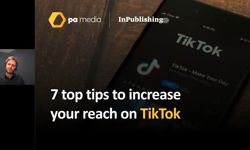
The last two years have been an extreme exercise in adaptability for publishers. It’s well recognised that the pandemic has accelerated change across the digital space. Combined with third-party cookie loss and growing data regulation, there has been an increased focus on societal issues, disinformation, and diversity, meaning publishers have juggled a host of rapidly shifting priorities, while still having to maintain the bottom line – and they have proved they are more than up to the task. As recent data shows, revenue figures for UK digital publishers continued to grow through 2021: reaching £149.4 million in Q3; a 31% increase from Q3 2020.
However, the list of shifting priorities continues to expand and publishers face an equally chaotic future, so now is the perfect time to pause and assess how they have adjusted so far – as well as what their next steps will be. In short, this is the moment for an industry health check.
In our ‘Digital Publishing; Meeting the Future’ survey, we asked over 100 companies across the publishing landscape to share insights on their existing strategies and state of readiness for the road ahead.
There is growing awareness that the best way forward will lie with pooling strengths and mutual support.
When the cookie crumbles
Having long dominated the industry agenda, publishers are broadly optimistic about cookie deprecation, rating their confidence in post-cookie preparations at 6.5 out of 10, where 0 is very unconfident and 10 is very confident.
Likely reasons for this are at least partly down to a rising emphasis on collective initiatives. Although 12% of publishers are unsure about their next steps, most have collaboration in mind at some level; with 20% already working with other publishers on data initiatives, 16% discussing it, and 40% open to the possibility. This illustrates growing awareness that the best way forward will lie with pooling strengths and mutual support.
Further cause for buoyancy also comes from greater mastery in wielding one of their key strengths: first-party data. Thanks to their direct audience access and understanding, publishers have found themselves in the spotlight as the gatekeepers of valuable, consented, and contextual data that will be crucial to monetisation – including ad targeting among other activities – after cookies fade. By becoming truly data-driven businesses, publishers can drive the way forward after the demise of cookies, rather than being dictated to by advertisers and agencies, who are intent on finding like for like replacements.
Given this growing emphasis on the importance of first-party data, we asked how publishers are leveraging audience data insights throughout their organisation – for example, across editorial, product, and commercial teams. While only 17% of publishers say that all their teams are aligned internally around their audience data, 75% of publishers say that they are working to ensure that audience data informs everything they do and are investing in tools to help achieve this.
There is some impatience from the solutions providers questioned in the survey; with 50% feeling publishers appreciate the importance of being joined-up internally, but don’t have a strategy in place. Yet, as the number of publishers able to connect data dots increases – now at 17% – streamlined use of first-party data is set to lay better foundations for cookie-free success across the board.
By becoming truly data-driven businesses, publishers can drive the way forward after the demise of cookies.
Looking beyond advertising
Another source of publishing confidence is a continued move away from a sole reliance on advertising revenue. When asked about core growth opportunities for the next few years, only 20% of publishers named display advertising as offering the most potential. This suggests publishers have succeeded in weaning themselves off income generated by advertising alone; a probability reinforced by the wide range of opportunities now featuring in diversified monetisation approaches.
Over half of publishers (55%), for instance, cite increasing user subscriptions as the greatest opportunity for growth. Although adoption of subscriptions is still relatively nascent – only 16% of consumers currently pay for a news subscription – there is growing demand among audiences for high quality content that’s driving openness to paid-for access; with 53% of global consumers saying they’d be willing to pay for a news subscription in the future. Already, we can see examples of this – such as The New York Times boasting 10 million online subscribers. At the same time, a third of publishers are looking to lead generation, while almost as many (31%) are looking to leverage new opportunities in audio – including podcasts and live radio – and ecommerce.
Over half (51%) of publishers see direct deals as having the most potential for revenue growth compared to private and open marketplaces. By working in partnership in this way, publishers can create really integrated audience and creative propositions that deliver significant commercial value to the client. Continued concerns from marketers around brand safety and authenticity would also be a key driver in encouraging agencies to work closer with quality media owners. Obviously, it goes without saying, advertising will always be an important revenue driver, but it’s clear publishers are eager to ensure consistently stable revenue by tapping a wider array of revenue streams and seeking more control over their own destiny.
75% of publishers say that they are working to ensure that audience data informs everything they do and are investing in tools to help achieve this.
Facing up to ongoing challenges
Publishers are also aware that safeguarding their businesses will take more than just tapping new sources of income. Several challenges continue to pose significant issues for retaining audience trust, presenting risks for the future of the entire digital media ecosystem. Key among these are misinformation and disinformation. Already a concern before the pandemic, problems with misleading online content have captured more attention amid accelerated news agendas and the hunger for reliable information about global events. In today’s turbulent political and social climate, there is a need for content producers of all types to take responsibility for championing trustworthy media and helping audiences make informed decisions; as recently underlined by the launch of the Online Safety Bill. However, when asked how confident they are in their understanding of the impact this legislation will have on digital publishers, the average rating from respondents was 4.5 out of 10, where 0 is very unconfident and 10 is very confident, meaning further industry discussions need to be facilitated to better understand the impact of the bill.
Over half of publishers (55%) cite increasing user subscriptions as the greatest opportunity for growth.
Unbiased hiring and talent nurturing
A prominent issue currently facing the digital publishing industry is a sizeable talent shortage, with 70% of publishers and 93% of solutions providers experiencing a shortfall across roles, and especially in journalism.
While this talent chasm has promoted a positive focus on retaining and supporting current workers for most publishers (75%), it’s encouraging to see that adapting their offering to appeal to new talent ranks closely behind, followed by eliminating bias and supporting underrepresented individuals entering the industry. Publishers feel that progress is being made in this area; over half (51%) believe their DE&I strategy has made good progress though there is still room for improvement, while 24% believe they have an effective DE&I strategy. Only 5% of respondents don’t believe they have a clear strategy on DE&I. Nurturing inclusivity in workplaces will be incredibly important as our industry continues to evolve; and baking in these processes early will put digital publishers ahead in the years to come.
Further industry discussions need to be facilitated to better understand the impact of Online Safety Bill.
Increased emphasis on consumer value
Equally, publishers recognise there are multiple levels where they can adjust ways of working to better cater for a wider range of communities and ensure consumers have the information needed to make up their own minds about online content. Publishers believe that one of the most effective ways to do this and respond to the challenge of disinformation and misinformation online is by hiring more diverse journalistic talent with an average priority ranking of 3.7, where 0 is not something they are focused on, to 5 being of high importance. Publishers are also keen to break echo chambers by actively amplifying diverse audiences (3.4), as well as taking a clear stance on issues to help share a counter-narrative to extreme perspectives (3.1). Taking a stance will be extremely important for publishers to demonstrate their commitment to the causes their audiences care about and to show their ethical principles. Moreover, many are looking to improve internal education around hostile narratives to ensure news stories can’t be repurposed to suit harmful agendas (2.6). Most crucially, the same number aim to empower consumers by providing tools and support needed to be more media literate (2.6).
Publishers continue to stay resilient despite having to keep an ever-growing number of plates spinning. Their ingenuity and ability to continually evolve has helped publishers to roll with industry shifts, even at an accelerated rate. There are challenges still to be tackled, but they know how to tackle them and now need to maintain momentum.
Nurturing inclusivity in workplaces will be incredibly important as our industry continues to evolve.
For further insights, you can download the full ‘Meeting the Future’ report from here | For more information about the AOP, contact: info@ukaop.org
This article was first published in InPublishing magazine. If you would like to be added to the free mailing list, please register here.










